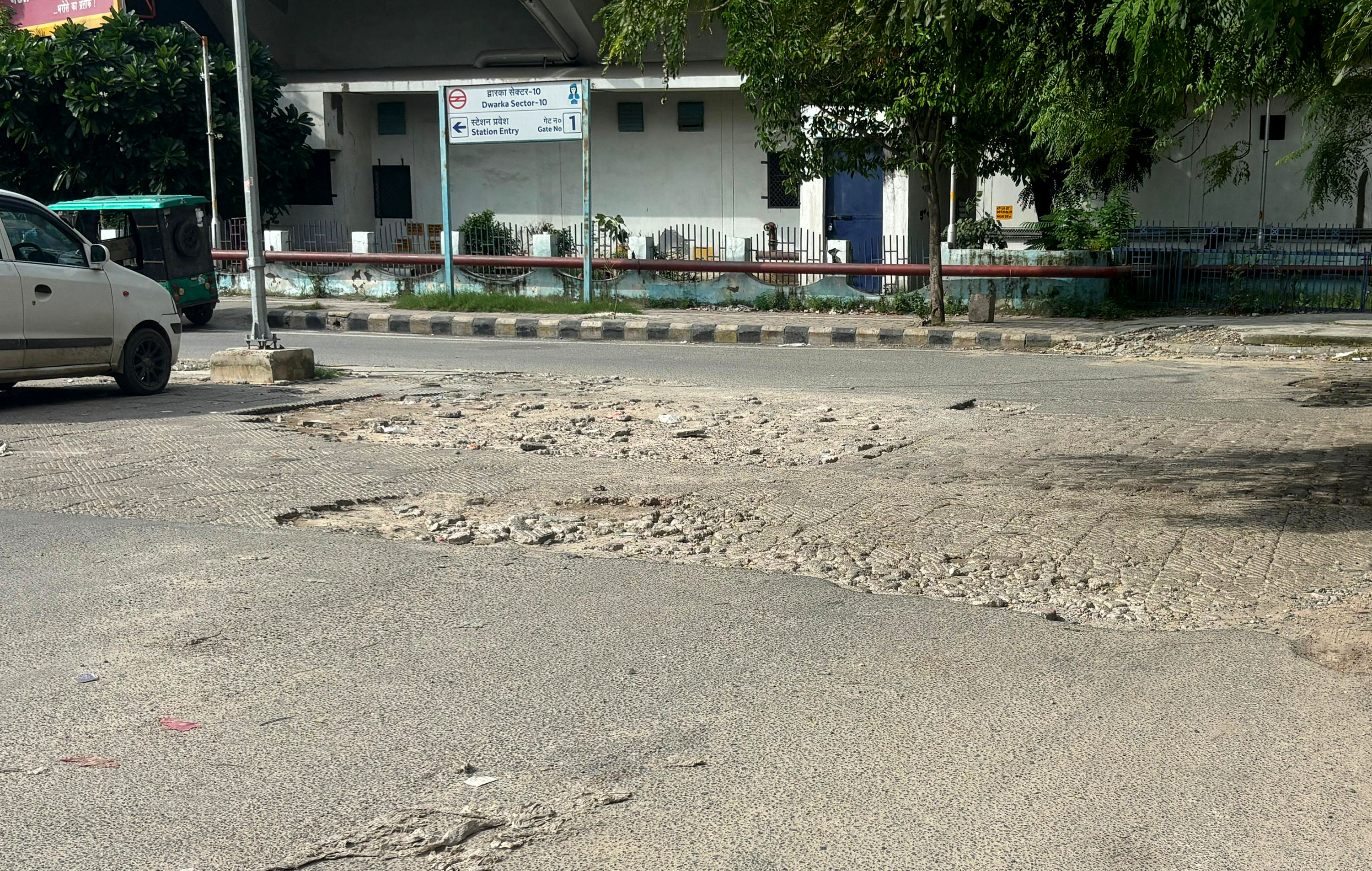Potholed roads promise a bumpy ride, fatalities
In March 2025, a 37-year-old man was on his way to work when his bike hit a pothole on the Mehrauli-Badarpur Road in South Delhi. Unable to navigate a water-filled patch, he collapsed and succumbed to injuries sustained in the accident. His life had been cut short by an act of civic apathy.
The Capital is full of these stories of government neglect, and the pothole story rumbles on.
A ground survey by The Tribune — from slums and semi-urban centres to upscale residential blocks and areas housing government offices — reveals the same sorry state of roads lying in disrepair and in urgent need of attention.
A stretch of road right next to Shramev Jayate Bhawan in Dwarka, Sector 10, home to the office of the Central Chief Labour Commissioner, is broken and pockmarked, presenting a dismal picture of civic upkeep.
 A damaged portion of a road near the Metro station adjacent to National Council for Teacher Education office in New Delhi. Photo by writer
A damaged portion of a road near the Metro station adjacent to National Council for Teacher Education office in New Delhi. Photo by writer
Outside the Dwarka Sector 10 Metro station, next to the National Council for Teacher Education office, the road resembles a piece of Swiss cheese with gaping holes and cracks that force vehicles to swerve dangerously.
“This situation is not anything new. The government filled up the road recently as well, but it’s back to being battered. When it rains, waterlogging makes it harder for vehicles to move,” said Shankar, a tea vendor serving piping hot cups to daily commuters near the Metro.
Outside the National Institute of Social Defence office, the roads are no better, with deep ruts that turn into mini-ponds during rains.
Across Delhi’s slums — from the cramped lanes behind the ITO railway bridge and the congested Seemapuri area in North-East Delhi to Najafgarh in South-West Delhi — potholes and broken roads have become a grim constant. Even posh localities like Defence Colony and New Friends Colony are not spared, where cratered roads greet residents and visitors alike.
“It’s a frustrating situation, but who can we complain to? No one listens,” said Mustakim, an e-rickshaw driver ferrying passengers through the battered roads of central Delhi.
Official data from the Delhi Public Works Department (PWD) paints a worrying picture. Of the 7,678 potholes identified across the city, only 4,003 had been repaired by April 2025.
What is worse, several complaints, including those filed by the Delhi Traffic Police to the PWD portal, remain unresolved. This increases the risk for the most vulnerable road users – pedestrians and two-wheeler riders. According to Delhi Traffic Police’s 2023 crash report, pedestrians accounted for 43 per cent of road fatalities, followed by two-wheeler riders at 38 per cent.
Talking to The Tribune correspondent, auto driver Ankur, who plies his three-wheeler between Janakpuri and Uttam Nagar, said the potholes take a toll on his vehicle too. “The roads are so bad that every few weeks, my auto needs repairs because water gets inside and damages the engine,” he said.
Shubham, a resident of West Delhi, echoed similar frustrations, saying, “Roads from Vikaspuri to Janakpuri are in a mess — potholes everywhere, no smooth patch left. This is just years of neglect and zero accountability. Political representatives only pass the buck instead of fixing the infrastructure.”
The situation is so dire that The Tribune had earlier reported how even PWD Minister Parvesh Verma’s own village is riddled with potholes.
While the PWD claims to be working on repairs, Delhiites can also take matters into their own hands by reporting potholes through the PWD Sewa mobile app or by emailing complaints to complaint@pwddelhi.com.
But until swift action follows these complaints, Delhi’s roads will remain a perilous maze of craters — endangering lives and underscoring the cost of civic neglect.
Delhi